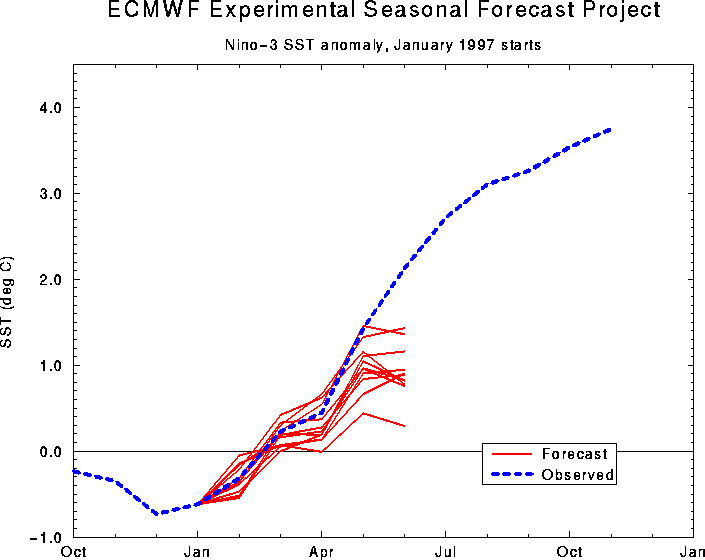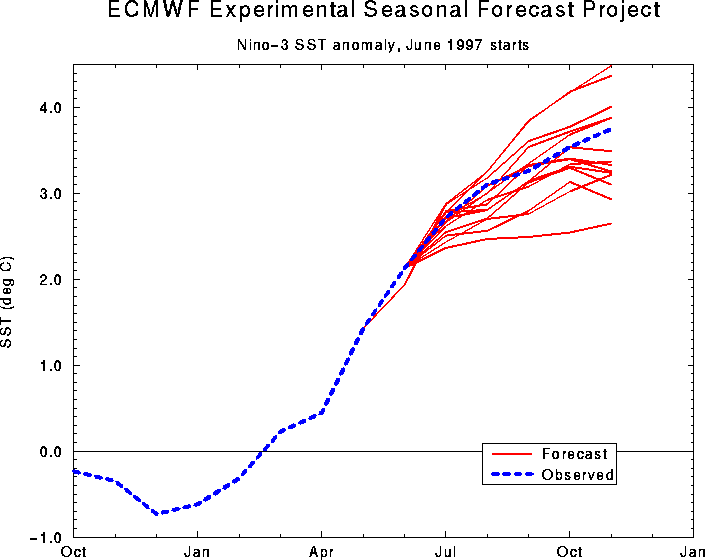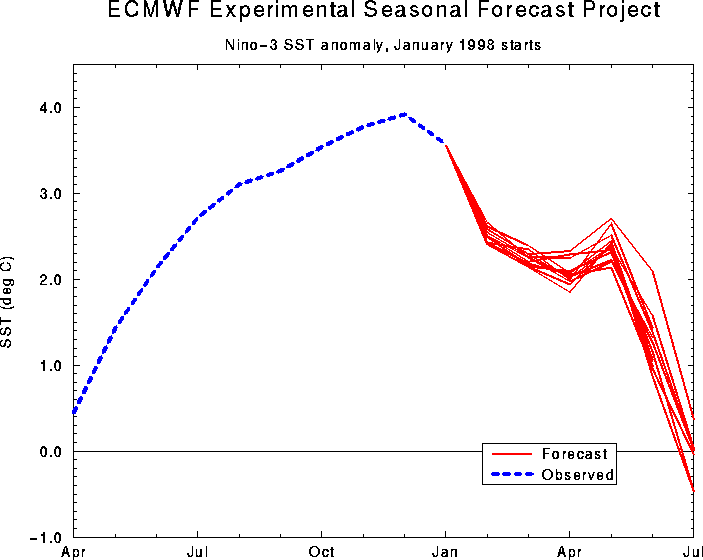
![]()
El Niño and human health

 |
Sari Kovats and Mark Cresswell
assess the potential benefits of seasonal forecasting for human
health with particular regard to El Niño events.
The authors are researchers at the London School of Hygiene and Tropical Medicine and the Liverpool School of Tropical Medicine, respectively. |
There has been much interest recently in the links between health and the El Niño-Southern Oscillation (ENSO) phenomenon. The major El Niño event of 1997/98 was linked to several severe disease outbreaks, notably serious epidemics of malaria, cholera and Rift Valley Fever. It has long been realized that the catastrophic weather associated with El Niño (heavy rainfall, flooding, drought) can trigger outbreaks of disease. Increases in respiratory and diarrhoeal diseases, as well as malaria, were reported in Peru following flooding associated with the 1982/83 event.
Health scientists have also become interested in possible links between El Niño and cyclic epidemics in areas where there are climate teleconnections. There may be great potential in applying the rapidly advancing science of seasonal, or El Niño, forecasting to disease risk and it is hoped that the health sector will be able to make good use of this information in health service planning.
The current state of knowledge concerning the relationship between El Niño and disease has recently been reviewed in a report shortly to be published by the World Health Organization (for availability, see page 14). This is a rapidly growing area of research.
Several mechanisms can explain an association between weather and disease, but the primary relationship of interest is between rainfall and mosquitoes. Mosquito vectors transmit many major diseases, such as malaria. The ecology of the local vector species needs to be understood in order to determine the epidemiology of the disease and attempt some measure of control. Atypical weather, for example, a heavy downpour, can increase vector abundance and trigger an epidemic.
This is what occurred in the Wajir district of Kenya in early 1998. Under normal weather conditions this region is too dry for the vectors and very little transmission occurs. There had not been a malaria epidemic since 1952 and the local health sector was unprepared for the major outbreak that followed the heavy rains.
Epidemics of vector-borne disease occur in unprotected populations which lack sufficient immunity and/or effective public health measures. Many regions in the tropics are without an effective public health infrastructure. In these regions, the transmission of vector-borne diseases has a natural boundary where climatological or ecological conditions limit the distribution of the pathogen or vector. In these “fringe” areas, small changes in weather between years may dramatically change the conditions for disease transmission.
Epidemic malaria can be a serious problem in arid areas. According to Bouma and van der Kaay, strong correlations are found between annual rainfall on the one hand and the number of rainy days on the other and malaria incidence in most districts of Rajasthan and some districts in Gujarat, the more arid areas of India and Pakistan. Years with a high risk of malaria and excessive monsoon rainfall can be expected in years following El Niño (+1 year) and during La Niña years. In very humid climates, periods of drought may turn rivers into strings of pools which are more conducive to vector breeding. In such regions, opportunistic breeding of vectors during droughts can provide epidemic conditions.
The southwest part of Sri Lanka which receives two monsoons is one of these areas. A historical analysis of malaria (pre-DDT) found an increase of the epidemic risk during El Niño. This risk was associated with the failure of the southwest monsoon, often combined with failure of the northeast monsoon in the preceding year.
Bouma and Dye have shown that malaria increases in the post-Niño year (+1) in Venezuela where El Niño is associated with dryer than normal conditions. Reduced streamflow may increase mosquito abundance by increasing the number of breeding sites but higher temperatures during El Niño episodes may also favour malaria transmission.
The reasons that malaria increases after a dry period are not completely understood. However, this strong relationship between malaria and ENSO in Venezuela and Colombia can be used to predict high- and low-risk years for malaria with sufficient time to mobilize resources to reduce the impact of epidemics.
What are the prospects for predicting climate and disease outbreaks? Dynamical seasonal forecast models are used to predict major climate trends up to four months ahead. A probabilistic seasonal forecast is usually limited to the likelihood of temperature or rainfall being above, near, or below normal (so called tercile categories). Predictions may be more consistent at different times of the year. Currently, the larger models in operational use provide global coverage, for the four main seasons.
There are two key seasonal forecast models in operation at present: the European Centre for Medium Range Weather Forecasting (ECMWF) Ensemble Prediction System (EPS); and the UK Met. Office HADAM3 model. The ECMWF forecasts are currently available via the Internet without restriction at www.ecmwf.int/html/seasonal/index.html.
Since the dynamical prediction models are highly sensitive to sea surface temperatures, the overall quality of the forecasts is greatly enhanced during El Niño events when the tropical eastern Pacific sea surface temperatures are higher than normal, improving the climate signal within the models. ECMWF produces rolling estimates of sea surface temperature anomalies in the critical NINO-3 region of the eastern Pacific (5N-5˜S, 90-150˜W). The figure below compares ECMWF forecasts of the 1997/98 El Niño event with observed temperatures at critical stages in the evolution of that event based on a sequence of NINO-3 plots.
|
|
|
Observed temperatures (dashed line) and a set of forecast temperatures (solid lines) for the NINO-3 indicator region in the tropical Pacific. Source: ECMWF |
It is important to determine whether the models perform better during anomalously warm and cool Pacific sea surface temperature episodes (that is, El Niño or La Niña events) than during periods when sea surface temperatures are “normal.” The use of “hindcasts” is being developed by ECMWF and the UK Met. Office to test the models during these periods.
Seasonal forecasts are only of value if they are shown quantitatively to be reliable and if intermediate and end users have access to them and the capacity to respond. This requires effective communication between all parties along the linkages between prediction centre, to intermediate user (usually the national meteorological and hydrological service) to the end user.
Climate forecasts at seasonal and interannual lead times may be of great importance in mitigating future epidemics in regions where a relationship between disease and ENSO has been established. In many countries, vector control measures have failed or resources are too limited to maintain adequate levels of control of vector-borne diseases such as malaria.
Climate forecasts at seasonal and interannual lead times may be of great importance in mitigating future epidemics in regions where a relationship between disease and ENSO has been established. In many countries, vector control measures have failed or resources are too limited to maintain adequate levels of control of vector-borne diseases such as malaria.
A pilot study concerned with the application of seasonal forecasting for malaria control was undertaken in the SADC (Southern Africa Development Community) region in 1998 by one of us (MC). This approach utilizes a consolidated forecast – an amalgamation of different models, with regional expertise.
The preliminary results were encouraging, and saw (possibly for the first time), the National Meteorological Service, agriculture and health delegates discussing their requirements at the same table. If the technology is to be taken up in Africa, more work will have to be done in assessing the regions and seasons where the forecast models work (and fail to work). Once people are confident with the performance of such data, they can begin to actively assimilate it into their own activities and control programmes.
Probability forecasts of rainfall amounts have been used by the World Health Organization sub-regional malaria control office in Harare, Zimbabwe, during the 1998/99 malaria season in southern Africa. Such information was regarded as “very useful” in the coordination of malaria control activities and targeting of resources during that period by one key user.
It is now possible to forecast the onset and progression of El Niño months ahead. There is great potential to use these seasonal forecasts to improve public health. Seasonal forecasts are currently used to enhance agricultural productivity and disaster preparedness, particularly as part of famine early warning systems. There is a need for the health sector to improve its capacity in the use of meteorological and climate information and predictions, maximizing the effectiveness of limited resources.
The increasing cost of effective insecticides and the development of drug resistance are likely to contribute to the increasing prevalence of malaria in the coming decades. The gradual increase of malaria worldwide, and the re-invasion of territory where the disease was previously controlled, are reasons for grave concern, with the risks exacerbated by the threat of long-term climate change.
Targeting control efforts to high-risk years increases the cost effectiveness of malaria control and the more judicious use of insecticides can delay the development of resistance. Early warning and epidemic preparedness are, therefore, important elements in the renewed global efforts to control malaria.
Further information
Report WHO/SDE/PHE/99.4, entitled “El Niño and Health” and authored by Sari Kovats, Menno Bouma and Andy Haines, is available from the World Health Organization at the address below and, in electronic form, from the WHO web site.
Mark Cresswell, MALSAT, Liverpool School of Tropical Medicine, Pembroke Place, Liverpool L3 5QA, UK. Fax: 44-151-7087319. Email: mark@liv.ac.uk. Web: www.liv.ac.uk/lstm/malsat.html.
Sari Kovats, Epidemiology Unit, London School of Hygiene and Tropical Medicine, Keppel Street, London WC1E 7HT, UK. Fax: 44-171-6127844. Email: s.kovats@lshtm.ac.uk. Web: www.lshtm.ac.uk/.
World Health Organization, Avenue Appia 20, CH-1211, Geneva 27, Switzerland. Fax: 41-22-7910746. Email: info@who.int. Web: www.who.int/.
On the Web
El Niño and the Southern Oscillation and Seasonal climate forecasts — El Niño and Africa in the Cyberlibrary list relevant links.


